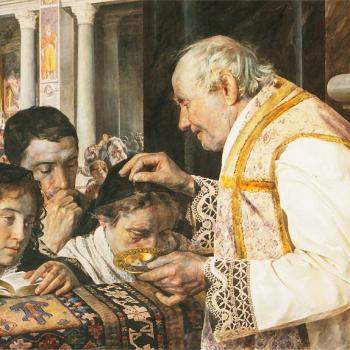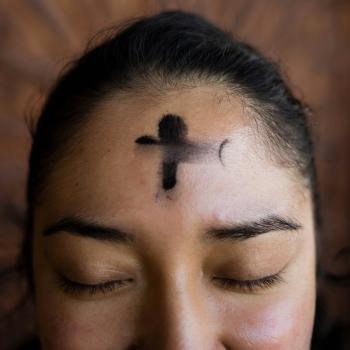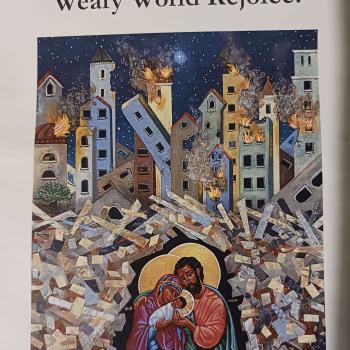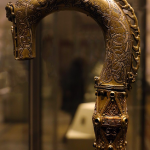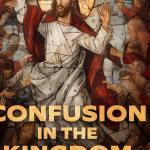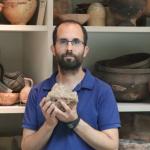This past Holy Week and subsequent celebration of Easter was a rough one for me this year. Too many realities converged which made it impossible to let the Triduum go by as usual. First, there is my continuing dissatisfaction with my usual parish community and my family’s inability to feel very comfortable at any of our local parishes, for various reasons. Second was the celebration of the 30th anniversary of Archbishop Oscar Romero’s martyrdom, the recollection of which should truly unsettle our christologies, our ecclesiologies, and our liturgiologies. And third, of course, was the new presence of clergy sexual abuse in the media, accounts of modern day crucifixions perpetrated by those who are supposed to represent the crucified, not the crucifiers.
The convergence of these realities led me to write a reflection here on the ways in which I anticipated complete silence regarding the crucified peoples of the world today, especially those who have been victims of sexual abuse in church contexts. In my own local Catholic world, silence is indeed what I experienced in a number of ways. First, prompted by a comment on the piece, I sent the reflection to about 5 or 6 friends of mine who are priests in my diocese. Granted, Holy Week is a busy week for most priests. But I was struck by the silence I met in sharing those words in this way — only one of my priest friends wrote back. He was thankful for what I wrote, and said he was challenged by what I said.
And of course the silence that I predicted — the disappearance of the crucified — dominated the liturgies at the parish I attended. The victims of clergy sexual abuse were completely absent from those three liturgies. Victims of contemporary violence of any kind were absent. On Holy Thursday we were treated to the usual “the-washing-of-the-feet-means-service” homily, likely plucked from the pastor’s file of greatest hits. Nothing about, say, the kind of “class treason” embedded in that gospel narrative. Friday we heard about how Jesus is our “spiritual water filter” and about how we each “die a little bit every day,” like when our kids get their driver’s licenses or leave home for college. (Note that the focus was on death rather than on crucifixion, i.e. execution. Resisting this overspiritualized nonsense, when I joined the procession to venerate the cross, I kept squarely in mind the daughter of a friend who was sexually abused by her soldier father.) And so then on Saturday, at an Easter Vigil liturgy attended by, apart from the choir, about fifty people due to the West Virginia-Duke Final Four basketball game, what else could we expect to follow a half-assed celebration of the cross but a half-assed celebration of resurrection? Amidst the American Idol stylings of some of the cantors (one was decked out in a black shirt and metallic red necktie) and occasional liturgical dance routines (could this parish not see the irony of having a young girl in a leotard dance before the celebrant at a time like this?), I kept raising my eyes to a large, gorgeous tapestry of Oscar Romero hung from the opposite wall. What, I wondered, would be Romero’s thoughts on this middle-class, crucifixionless Easter celebration?
The Triduum I experienced, in the context of this community especially, was empty. Silent. It was, in a sense, liturgical death.
Do not get me wrong — my disappointment is not a matter of disagreement with “contemporary liturgy.” It is a matter of the tendency in official, parish-based, middle-class Roman Catholicism — and other forms of middle-class Christianity — to overly spiritualize the mysteries we celebrate such that our celebrations become what I have called a “willful liturgical obscuring of the continued crucifixion of Christ today.”
I admitted to a friend the other day that, during the Triduum, I was not in the best “spiritual space” so to speak. Upon further reflection, though, I completely disagree with that way of looking at it. I was in a very good “spiritual space.” I experienced in those days, even on the day of Easter, a kind of crucifixion. Not the “cross” of not getting along with a co-worker or my in-laws, but the cross of suffering through a literal and liturgical denial of Christ by my parish community. We often, as a church, simply do not know our Lord and do not want to know our Lord. “I do not know the man!” Feeling the emptiness and the darkness of that place was a real grace for me this year. A very good and very necessary “spiritual space.”
In the course of those days, I finished reading a classic work of Latin American liberation theology, Freedom Made Flesh: The Mission of Christ and His Church by Ignacio Ellacuría (Maryknoll, NY: Orbis Books, 1976), a close friend and advisor to Oscar Romero and one of the Jesuits martyred in El Salvador in 1989. While I have some ambivalent feelings about the book, as Ellacuría is one of the few Latin American liberation theologians who made an explicit defense of the possibility of legitimate liberationist violence, the book is a fantastic account of the “historicity” of the life of Jesus of Nazareth and of the church as the ongoing presence of Christ (sacrament) in history.
“History” is of course central to Christianity. We Christians speak all the time about “salvation history,” the various historical events through which God has been working to save humanity. And because of this we think we take “history” very seriously. But as Ellacuría once wrote, “There is no history of salvation without salvation in history.” This view of the radical historicity of salvation is what led Ellacuría, and later Romero and Sobrino, to speak of the “crucified peoples” in the world today as Christ’s body, the continued presence of the crucified one in history. What needs saving in this world, I think Ellacuría would say, needs to be identified concretely. And it is the task of those who follow Christ to “take the crucified down from their crosses,” as he would often say.
And this brings us back to my concerns with the celebration of the Triduum that I experienced, because Ellacuría’s understanding of the historicity of salvation has everything to do with liturgy. In the book’s epilogue, entitled “Liturgy and Liberation,” Ellacuría wrote:
[The] saving word must be relived in the context of the actual historical situation, and it must be converted into here-and-now Christian experience. If it is not, it will find no listeners; it will be nothing more than a jumble of meaningless sounds, shedding no light on human lives and possessing no sacramental efficacy. (236)
And then in the section on the sacrificial nature of the Mass, Ellacuría wrote:
The Mass, which is first and foremost a sacrifice, is the most obvious locale for living out [the] Christian reality [of death and resurrection]. But there is a potential danger here too. We may place too much emphasis on its unbloody nature and on its intrinsic efficacy quite apart from the operative faith of the believer. Then we tend to take refuge in such notions as “purity of intention,” “interior death,” and a “poverty of spirit” wholly divorced from poverty in our lifestyle. We tend to go in for purely secular and profane activities that are a far cry from the gospel message, excusing ourselves on the grounds that our motives are pure. We prefer to “die” at morning Mass than to die with the oppressed people around us, feeling disinclined to look for the dying Chrst amid these people. But it is the ongoing passion and death of Christ in history that we should be living in the sacrifice of the Mass.
To be sure, the liturgical texts now in use in the Mass and the sacraments do not help us very much to grasp what dying and rising with Christ really means…. People are dying in real life. We all are summoned to die in real life. That must somehow be brought out in the Mass. (245-6)
And of course, these are not the words of an ivory tower theological intellectual. They are the words of a priest and teacher who looked for the dying Christ among the oppressed peoples around him and who indeed died with them.
Ellacuría reminds us not to let our dying and rising get too “spiritualized.” Part of the concrete “dying” that many of us in the Roman Catholic Church are experiencing has something to do with the anger brought on by the scandalous behavior of so many of our ecclesial leaders, the anxiety in feeling that the church as we know it is perhaps “passing away,” and of course the pain we feel in solidarity with those who have been abused by the church. For me, and probably others, an added dimension to this “dying” is the feeling of horror that so many Catholics, including many of our hierarchs, seem completely oblivious to these realities — blaming the media, gays, and Jews for “crucifying” the church and celebrating ahistorical liturgies that simply reinforce spiritual myopia. This is a real death.
So where, then, is this promised “resurrection?” Glimpses are hard to come by, as we so clearly remain on the way of the cross, but I did receive a concrete glimpse of the resurrection this past Saturday at liturgy.
A friend of mine is a teacher at a Catholic parish middle school in a city about an hour from me. The parish is the richest Catholic church in the state of West Virginia in the middle of a staunchly republican city. A couple days after the mine explosion in southern West Virginia on Easter Monday, my friend called me to tell me that the assistant pastor at the parish was planning to criticize Massey Energy, the owner of the mine, and its CEO Don Blankenship from the pulpit. As I have never, ever heard a homily critical of “Big Coal” in my home state, I decided to make the trip to hear the homily.
Coincidentally, members of the Westboro Baptist Church were scheduled to protest outside of the church during the Mass. They had planned to be there for at least weeks, intending to protest at Catholic churches and institutions in the state in response to the sexual abuse scandal — some of their signs read “Your pastor is a whore” — but the mine explosion gave them an opportunity to pull out their “God loves dead miners” schtick. (In case you’re not aware, the Westboro folks believe that God intentionally kills u.s. soldiers and coal miners as a punishment for “tolerating” homosexuality in society.)
The homilist tied together the Massey accident, the Westboro hate group’s appearance at the church, and the sex abuse scandal in his homily. He expressed disappointment in realizing that some of his parishioners must agree with the views of the Westboro Baptist Church (“Just get rid of the gay priest, and we’ll no longer be front page news”). Riffing on the “doubting Thomas” gospel reading, he insisted that we need to stop having doubts about the “dangerous story of Jesus,” and that faith in this story will require that we become “doubting Thomases” with reference to some of the assumptions that we take for granted in our world and in our church. In particular, he said, we need to doubt what we have been taught about gay and lesbian people, and we need to doubt that the heads of corporations like Massey Energy care about the safety of their workers more than they do the generation of profit. On the latter issue, he was unambiguous in saying that Massey and Don Blankenship are murderers and need to be held accountable for what they are doing to the people and land of southern West Virginia.
What is that? What is that sound? That strange sound here in the church? The Gospel? The Gospel made concrete?
It was clear from the homily that this priest was also experiencing a kind of crucifixion with all that is happening in the church, in our state, and in our world. There was a heartbrokenness there, a kind of admission that something (maybe many somethings) needs to die in our church. “We are summoned to die in real life,” Ellacuría says. But in embracing that cross, some of us in that congregation caught a glimpse of the resurrection and a glimpse of the church as it could be — a church of compassion and justice, and of prophetic solidarity with those who suffer. That homily, and the Eucharist that was its context, was a resurrection moment for me, a sign of hope that somewhere deep down, this church retains something of the Gospel underneath all of its ugliness.
Alleluia! He is risen! He is risen indeed!








